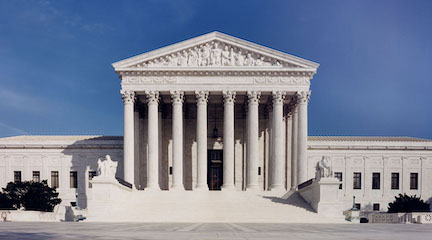 |
A Vacancy on the Court | <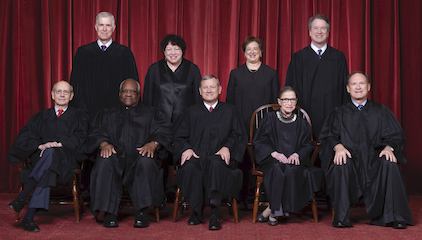 |
The Barrett NominationThe Ginsburg Vacancy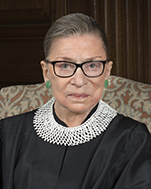
When Ruth Bader Ginsburg was appointed by President Clinton in 1993, some concern was expressed by Democrats that, at 60 years of age, she was too old and would not have the longevity desired by the party faithful. After all, only two years earlier President Bush appointed 43 year old Clarence Thomas, now approaching his 31st year. She had anticipated retiring during the presidency of another Clinton, but to her great horror, the presidential electors produced Donald Trump, who was destined to make two appointments in his first two years, securing the conservative Supreme Court partisans on the right have long awaited. Or at least so they thought. A near dying wish by Ginsburg was to not allow President Trump to appoint her replacement. You can easily find testimonials, biographies, legal analyses, even a biopic on the life of Ginsburg. I encourage you to acquaint yourself with her extraordinary life and contributions to life in America. We are more concerned on this site with what her vacancy means for the Court and for the appointment process. For decades, the Court has relative definable voting blocs on cases involving issues that produce different ideological perspectives. Conservative and liberal divisions are quite clear in about 20-25% of the cases heard by the Court as represented by 5-4 decisions, occasionally 6-3. In the 2019 term, 11 of 14 such cases were decided by the conservative bloc. The SettingOne need not look at the setting variables to know that this will be a controversial nomination. Despite a more solid Republican Senate majority and slightly more favorable rating for the president than with the Kavanaugh nomination, the fact that the presidential election was only 46 days away, and President Trump was presented with his third nomination, one that promises to put Court decisions beyond any hope of being controlled by the liberal bloc on the Court, set to be reduced to three members. Republicans, unbothered by their "let the American voters decide" rationalization of allowing President Obama's nomination in a presidential election year languish over a 293-day period, found other reasons to move quickly to fill this vacancy. While this makes for a great case study in political casuistry, this nomination introduces another contentious issue in an already contentious presidential election, one that each party hopes will galvanize their voting base to turnout. Early polling indicates 60% or so of independents think the nomination should be made by the winner of the presidential election, but I suspect that belief is insufficient to motivate their vote one way or another. The significance of this vacancy can hardly be understated. The replacement of Kennedy with Kavanaugh helped establish the most solid 5-person conservative bloc of five in the 50-year effort by Republicans to achieve this end. In the 2019 term, 11 of the 14 5-4 decisions involving ideological positions were decided by the conservative bloc. The opportunity now to establish a liberal-proof 6-3 split, is seen as is gold for Republicans. Democats are beside themselves. They need four Republicans to help them bloc an appointment, and only two (Collins-ME and Murkowski-AK) spoke in favor of letting the next president get the nomination. If Democrats find some way to delay until after the election, they could conceivably reduce the number of Republicans needed to 3 due to a special election in Arizona that might permit a Democratic winner to take office in November. See the Nomination Setting page for more detail on the setting. The Nominee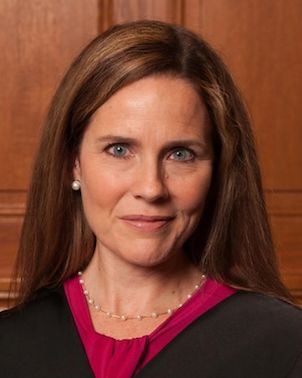
Born January 28, 1972, in New Orleans, Amy Coney Barrett received her BA degree from Rhodes College in Memphis and graduated summa cum laude from the University of Notre Law School in 1997. She clerked for Justice Scalia, coming back to Notre Dame as a professor of law from 2002-2017. She was appointed by President Trump as a judge on the U.S. Court of Appeals for the Seventh Circuit, headquartered in Chicago and covering Wisconsin, Illinois, and Indiana. Barrett will likely be considered as the anti-Ginsburg, with a juridprudence that emphasizes a Scalia-like originalist, textualist approach. (While much has been made of the friendship between Scalia and Ginsburg, on ideological splits on the Court, the two were almost never in agreement.) More importantly, Barrett has indicated a certain disregard for stare decisis at the Supreme Court level. She has a published record on these topics in various law reviews and conference presentations. You may find links to Barrett's publications through a university library and of some other presentations at the Federalist Society website. Barrett's confirmation to the Circuit Court was a partisan affair, a party line split on the Judiciary Committe and a 55-43 vote in the Senate, with only three Democrats voting to confirm. She will have a strong appeal to the Christian evangelical Republican base, and Republicans will emphasize too her Notre Dame education as being non-Ivy league and her role as a mother of seven children. Her confirmation seems assured. Democrats can only hope to portray her as too conservative and one who is ready to overturn any number of major cases already thought settled. On the other hand, Democrats may wish to take a softer approach and not risk battling this particular nominee. She shows well, is smart, composed, and has the credentials that virtually assure her confirmation. Lacking the filibuster to bloc a nomination, Democrats might wish to lay the groundwork for future battles. It remains to be seen how her version of textualism meshes with that of Gorsuch and whether that might bring her to join with the liberal bloc on certain issues. Gorsuch found himself with the liberals on 6 of 29 5-4 decisions over the past two years, though half of those dealt with tribal rights,
The InterimThe interim period is that time between the nomination and the vote in the Senate. It encompasses public reaction to the nomination, the activities of advocacy groups, press coverage, as well as the Senate Judiciary Committee hearing and subsequent committee activity. Use the links on the left to inform yourself about these various aspects of the process. What typically happens next for a nominee is a number of visitations to Senate leaders and members of the Senate Judiciary Committee. Simultaneously, the Judiciary Committee has the nominee complete a comprehensive questionnaire, and each senator on the committee will either assign a staff member to compile an independent file on the nominee or agree to work together with another one or more other senators to gather information in preparation for the hearing. A background check by the FBI is also standard procedure for such nominations. Senate Republicans and Democrats each have distinct preferred outcomes for this nomination. Republicans want to establish a reliably conservative Supreme Court they have sought for almost 50 years, and they want it done before the election. That could be important. The election could be a hot mess. President Trump has given every indication that he may pursue a variety of actions to ensure his election. Such actions may well end up in the courts. This conjurs up a replay of Bush v. Gore from the 2000 election in which a 5-4 Court decision stopped a Florida recount that may have delivered the state to Gore, not Bush. The Democrats sought to prevent that pre-election confirmation outcome, if not by defeating it then by delaying a vote past the election in the hope of regaining the Senate and wining the presidency, adding support for their claim that the appointment should be put on hold. Both parties claimed the moral high ground and accused the other side of playing politics. They've got the politics part right, and understanding that helps to more properly evaluate their rhetoric. One side may actually occupy the moral and/or logical high ground. More importantly, you will likely believe that one side's outcome is better for the country than the other side. Politicians are great gymnasts, specializing in flips that justify opposite actions without breaking stride. In 2016, Senate Republicans refused to consider President Obama's Supreme Court nomination of Merrick Garland for 10 months, allowing the Court to limp along with eight justices for portions of two terms. Now, with the nomination of Barrett, it's imperative that the vacancy be filled as soon as possible in order to fulfill presidential and Senate constitutional responsibilities and delay the work of the Supreme Court as little as possible. Efforts to claim the high ground in justifying their actions only revealed that, once again, in politics, all too often the end justifies the means. Click on The Court link to read a blog entry on the political casuistry evident in this nomination. The SenateThe timeline set by the Republicans for the process is quite rushed, beginning the Judiciary Committee hearing on October 12 with a view to Senate consideration by the 26th and approval before the election. Nomination to confirmation has typcially run about 70 days or more. The Republican schedule anticipates the shortest confirmation process since Sandra Day O'Connor'a nomination by President Reagan in 1981. Her confirmation process was particularly short because there was effectively no controversy. Democrats could hardly oppose the first woman nominee to the Court, and Republicans had to support their president. Indeed, the only opposition that surfaced was from a few Republican conservatives. As the ideological composition of the Court has become increasingly signficant to the parties, the confirmation process has become more contentious. Barrett unlikely to receive any Democatic votes, not only because they did not want Ginsburg replaced by an anti-Ginsburg, but because they objected to the fast-tracking of this nomination so close to the presidential election. After all, they held out hope of being able to make the nomination for this vacancy themselves. 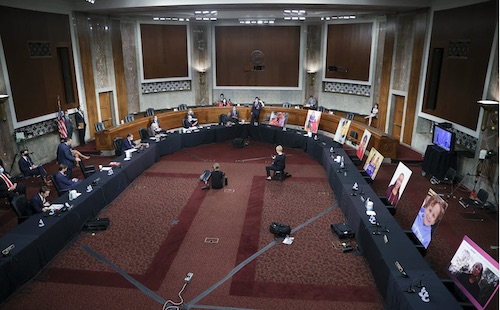
The hearing was relatively tame, and there were no suprise allegations requiring a delay in the process. Chair Lyndsey Graham scheduled 12 hour sessions to insure a quick heariing. Republicans played the expected roles of positive partisans—praising the candidate, asking questions to permit Barrett to look good—and advertiser, in which they displayed their own pet issues and preened for the home-state audience. Democrats, for the most part, did not pursue a hard line, in part because of the ability of nominees to deflect such interrogations. Instead, many went the advertiser route themselves, attempting to show the importance of the Affordable Care Act to the nation, an issue that Barrett will help determine its constitutional status. In a first, the Democrats boycotted the Committee vote, choosing instead to place large photos of individuals benefitting from the ACA in an attempt to personalize this issue. Democrats, of course, were playing to the electorate, hoping to persuade voters that the ACA was in jeapordy. The Committee Republicans voted 12-0 to recommend confirmation. The Senate went through the motions, both sides playing to the electorate hoping to get out the vote in support of their respective positions. The vote on October 26 52-48 was strictly along party lines except for Senator Susan Collins (R-ME), tightroping for re-election. She had publicly opposed there being a nomination prior to the election. Once confirmed, the new justice takes two oaths. The constitutional, common to all federal appointees, which was administered by Justice Thomas in the White House later that evening and the judicial oath, administered by Chief Justice Roberts at the Supreme Court the next day. 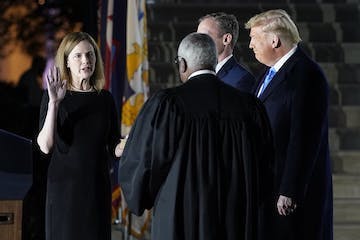

Updated on November 10, 2020, by George Watson |